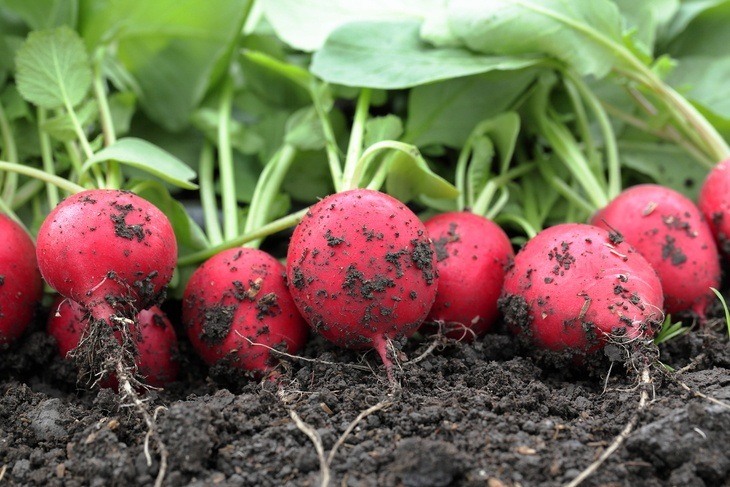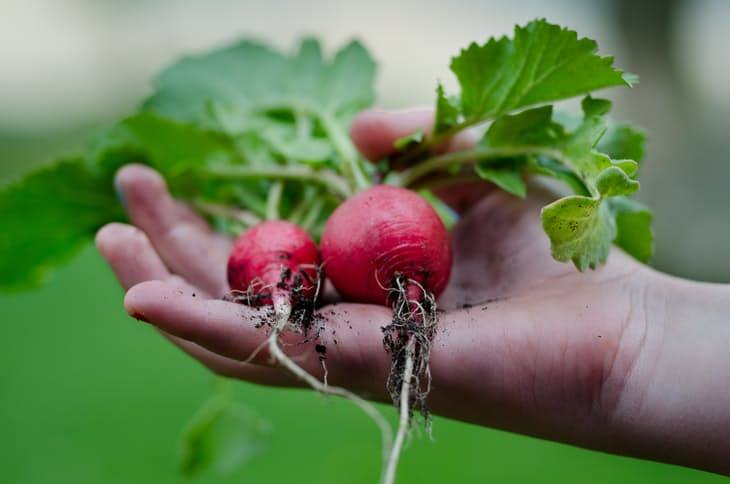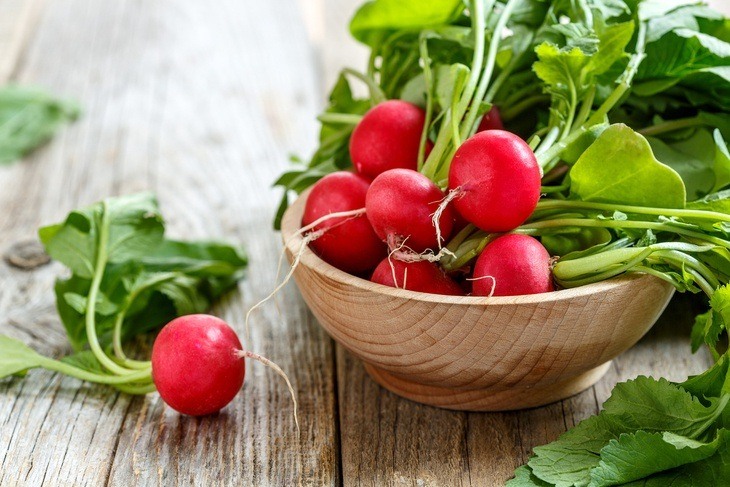Do you know how to store radishes? Radishes have emerged as one of the fastest growing garden crops. They’re quite easy to plant, and with sufficient rainfall in the fall or spring, gardeners can enjoy their crisp and crunchy nature for a long time. The trick to making sure that this nutritious and tasty vegetable does not die out after harvesting is to follow these steps.

Fresh radishes from a harvest
Here are eight steps on how to store radish after a harvesting period:
1. Harvest From The Dry Soil
After some few days of improved dry weather, dig and pull out the radishes. I mention improved dry weather because of the dangerous effects of too much water on the radish roots. Research shows that this moisture causes the roots of this nutritious plant to rot.

Radishes just pulled out from dry soil
Furthermore, dry weather eliminates the presence of root hairs. Through this, the plant becomes dormant and improves its shelf life by some few days.
2. Hydro-Cool For Storage On A Short Term Basis
If your intention is to eat the harvested radishes within a short period (say, within a week), here is an easy way to store your vegetables. Put one to two inches of water in a baking pan or shallow bowl, then place your radishes in the pan or bowl.
It is advisable to have the plants appear as if they are growing from the water and not out of the soil. You will eventually note that at room temperature, the roots and greens will retain their fleshy nature for a couple of days. If you decide to put the pan in the fridge, you will find wilting within five to eight days.
3. Chop Or Cut Off The Leafy Parts Or Greens
After you’re through harvesting your radishes, it’s also important to remove the leafy parts. Do this by cutting them off at the area where the stems come into contact with the roots. The next step is keeping the roots in a plastic bag then put in into the fridge, up to when you decide to eat them. Careful research shows that radish roots last for about two weeks while sealed in a plastic bag.

Radish roots without the leafy parts
For the radish greens, you have cut them off and store them using a touch of some ingredients. They may be excellently sautéed or braised in olive oil with a pinch of salt, pepper, and garlic.
4. Store The Radish In A Pool Of Water
I have found out that keeping radish roots in water is also effective, especially if you’re not willing to use hydro-cooling. Here, what you have to do is trim and wash the radish roots to remove the leafy parts and the small-like tap roots which grow from the bottom.
Drain the excess moisture and put the vegetables in a canning jar, preferably large with layers of cut and trimmed radishes. Proceed on to filling the remaining part of the container with water, cover it with a lid, and store it in the fridge. Eventually, the roots retain their crispy nature for an eight-day period.
5. Zip/Close And Seal
Another step of making sure that your radish vegetables last longer is placing the unwashed radishes and their leafy parts in a zip-top plastic bag. It should have a slightly folded and damp paper towel at the bottom.

Good taste and good nutrition
Lastly, store the bag in a cool, moisture sufficient, dark environment, for example, in the crisper compartment found in the fridge. While stored in this way, your radishes will stay fresh for a couple of weeks.
6. Store The Harvested Radishes In A Cellar System
If you’re facing limited fridge space, don’t let your radishes get spoilt. Research shows that you can also keep them in a basement or even a root cellar. Whichever choice you pick, it’s important to maintain the right temperature.
Keep this nourishing vegetable in temperatures of thirty-four to forty-two degrees Fahrenheit, and at a high humidity of ninety to ninety-five percent.Fill the cardboard with slightly mushy sand and spread the dirty roots between the sand layers.
Here, make sure that no root comes into contact with another. The main reason behind this is to prevent cases of rot from spreading. This method of storage will require you to constantly check the roots to make sure rot does not occur, and also to remove the infected roots if any. You will note that with sufficient storage of sand, your radish roots last up to two to three months.
7. Store Radishes In The Dirt
I have also noted that you can keep full-grown radishes in the soil. How do you go about this? Within the thirty days before the first expected frost, plan for a late-season sowing of the salad radishes.

You can store your radishes in the dirt!
During cold weather, the roots will not grow. When this happens, then it is important to guard them using a thick straw layer or hay of about four to five inches.Provided the ground stays frozen, you can harvest your radishes one at a time.
Another technique is covering the radish plants using a double layered floating row or establishing a small greenhouse.
8. Keep The Radish In A Cold Frame
Another in surface storage option for storing your fall-sown radishes is in a cold frame. The advantage of using this method is that you are able to enjoy the freshly harvested plants in the winter, fall, and spring.
Sow a few new seeds every week and add the soil of the cold frames with small inches of well-kept manure or compost, twice in a season. Lastly, having a sloped cold frame helps in heat and light absorption and it should mostly face south with a forty-five degree ideal temperature.

Freshly harvested radishes
Conclusion
Above are some practical ideas on how you can store your radishes after harvest. Radishes are very nutritious vegetables, so it is of utmost importance that they are properly handled after harvest to avoid loss of nutrition. They are also highly perishable!
Following any of the procedures discussed will certainly help you enjoy the fruits of your radish harvest for a long time.